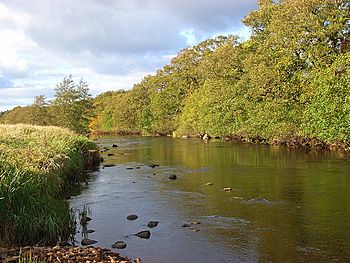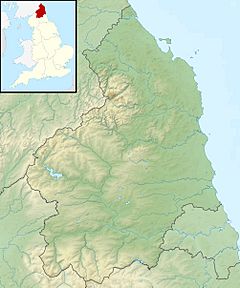River Rede facts for kids
Quick facts for kids River Rede |
|
|---|---|

The River Rede
|
|
|
Location of the mouth within Northumberland
|
|
| Country | United Kingdom |
| County | Northumberland |
| Physical characteristics | |
| Main source | 55°20′35″N 2°28′01″W / 55.343°N 2.467°W |
| River mouth | 55°07′55″N 2°13′17″W / 55.13204°N 2.22147°W |
| Length | 32 miles (52 km) |
| Basin features | |
| River system | River Tyne |
The River Rede is a river found in Northumberland, England. It starts high up on Carter Fell, which is close to the border between England and Scotland. The river then flows into the River North Tyne near the village of Redesmouth. The Rede is very special because it is one of only two rivers in the North East England that is home to the rare freshwater pearl mussel.
Contents
The River's Journey
The River Rede begins its journey on Carter Fell. This area is part of the Whitelee National Nature Reserve. From there, the river flows mostly towards the south-east. It is the main water source for the Catcleugh Reservoir. This reservoir was built a long time ago, finished in 1905.
The river continues through an area called Redesdale. It flows alongside the A68 road. Further along, it meets another stream called the Otter Burn in Otterburn. After this, the Rede turns south, then west near East Woodburn and West Woodburn. Finally, it flows south through Redesmouth before joining the River North Tyne.
What's in a Name?
The name Rede comes from an old English word, Rēade. This word means the red one. The river likely got its name because of the color of its water or the soil it flows through. The village of Redesmouth is named after the river, as it's the place where the Rede's mouth (where it joins another river) is located.
River Area and Water Flow
The River Rede is about 32 miles (52 km) long from where it starts to where it meets the River North Tyne. The area of land that drains water into the Rede is called its catchment area. This area covers about 60 square miles (156 km2).
In the upper parts of the river, the land is mostly uplands. Some of this area is even part of the Kielder Forest Park. As the river flows further down, the landscape changes. It becomes more like grassland and open heathland. The ground underneath is made of clay, river mud, and peat.
Amazing River Wildlife
The River Rede is a great place to see wildlife. You can often spot salmon, trout, and otters in its waters. But the most famous resident is the freshwater pearl mussel.
The Freshwater Pearl Mussel
The Rede is one of the few places in England where these special mussels live. In 2006, experts thought there were about 50,000 mussels in the Rede and the North Tyne rivers combined. These mussels are very important for the river's health.
People have started several projects to help the mussel population grow. One project aims to stop too much dirt and mud (called sediment) from flowing into the river. Another project involves adding freshwater trout to the river.
Helping Mussels with Trout
In 2011, about 11,000 trout were released into the river. These fish were raised at the Kielder hatchery. Why trout? Because tiny baby pearl mussels (called larvae) attach themselves to the gills of fish like trout. The fish then help carry the mussels to new parts of the river. This program hopes to help new mussels grow and spread throughout the Rede.
Cleaner Water for Mussels
In the past, water from Catcleugh Reservoir was sent through pipes to another reservoir. When these pipes were cleaned, the dirty water was sometimes pumped into the Rede. Even though the dirt was harmless, it wasn't good for the mussels. In 2019, a big project costing £500,000 was put in place to stop this from happening. Now, the river gets cleaner water, which is much better for the pearl mussels.
Streams Joining the Rede
The River Rede is the main stream that flows into the River North Tyne. But many smaller streams, called tributaries, flow into the River Rede itself. Here are some of the main ones:
- Bateinghope Burn (r)
- Coomsden Burn (r)
- Ramsden Burn (l)
- Chattlehope Burn (r)
- Cottonshope Burn (l)
- Blakehope Burn (r)
- Bellshiel Burn (l)
- Sills Burn (l)
- Rattenraw Burn (r)
- Durtrees Burn (l)
- Dargues Burn (r)
- Otter Burn (l)
- Raylees Burn (l)
- Miller Burn (r)
- Brigg Burn (r)
- Lisles Burn (l)
- Chesterhope Burn (l)
- Broomhope Burn (l)


